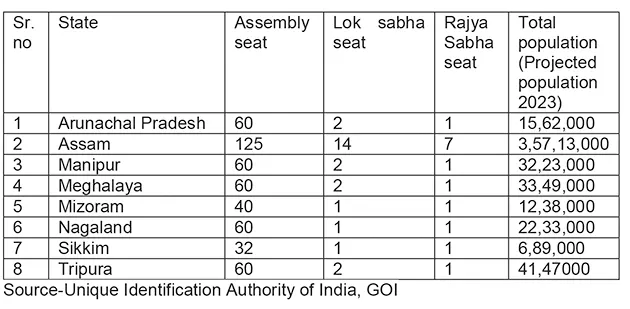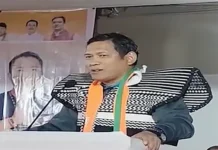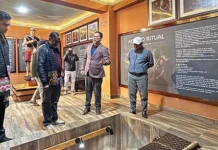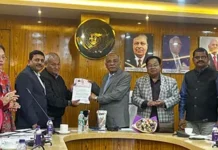[ Dr Topi Basar ]
The much-awaited 33% reservation for Indian women in the Lok Sabha and legislative assemblies (LA) is going to change our political landscape in a remarkable way. Indeed, a historic decision by the government. However, with excitement there is somescepticism concerning its actual implementation and the delay in the manner of its implementation. Before 33% reservation is enforced, the government will have to complete the long-pending census as the 2021 census could not be held due to the global pandemic. The government has indicated to begin the process of census from 2026. Thereafter, the Parliament will enact the Delimitation Act of 2026 as every census is followed by delimitation of parliamentary and assembly constituency undertaken by a high-powered delimitation commission constituted by the government. This will be carried out with the help of the Election Commission of India. Thus, 33% women reservation is dependent upon the census report and delimitation commission process, which in itself is a time-taking exercise.
After the census, the delimitation commission shall readjust allocation of seats in the House of the People to the states and undertake division of each state into territorial constituencies in such manner as the Parliament may by law determine (refer Art 82 & 170 of the Constitution), including reservation for SC, ST and 33% women reservation in the Lok Sabha and legislative assemblies.
Delimitation literally means the act or process of fixing limits or boundaries of territorial constituencies of the sates, an exercise undertaken after every census in order to readjust the territorial constituencies and seats in proportion to the population. In India, four delimitation commissions have been constituted so far under the Act of 1952, 1962, 1972 and 2002. There was no delimitation after the 1981 and 1991 censuses.
As per the Constitution, the Lok Sabha has a total of 543 seats and the Rajya Sabha comprises 250 members. The main objective of delimitation is to ensure that allocation of seats in the Lok Sabha should be based on the population of each state, so that the ratio of seats to population is as close as possible to being equal across all states. It is intended to ensure that each person’s vote carries roughly the same weight, regardless of which state they come from. Hence, population becomes the main criteria for seat allocation; as a result, the least populated states are disadvantaged compared to the more populated states. In order to balance this, government by the 42nd Constitutional Amendment Act, 1976 froze the Lok Sabha seat as per the 1971 census. The 87th Amendment Act of 2003 provided for the delimitation of constituencies on the basis of 2001 census but without altering the number of seats allotted to each state in the Lok Sabha.
It is pertinent to mention here the delimitation of Jammu and Kashmir after the abrogation of Article 370 and the Jammu & Kashmir Reorganisation Act.The delimitation commission was set up on 6 March, 2020 and used the 2011 census. It also became controversial because constituency boundaries wereredrawn only in J&K when delimitation for the rest of the country has been frozen until 2026. In case of Arunachal Pradesh, Nagaland and Manipur, no delimitation exercise has been done since 1971, the exception being Assam, where it was carried out in the recent past (only territorial readjustment done, no increase in seat). A PIL on this has also been filed before the Supreme Court by the Delimitation Demand Committee for Assam, Arunachal Pradesh, Manipur and Nagaland, whereupon the court directed the government not to defer the delimitation exercise for these Northeast states indefinitely consequently under the delimitation commission set up on 6 March, 2020 for Jammu & Kashmir it included these four states also. However, it could not be carried out in Arunachal, Nagaland and Manipur by the commission on the ground of security issues and objection over applying the 2001 census. As the states feared that their present demographic change would not be reflected by the 2001 census and fear of reduced seat as a result of territorial readjustment. The present position of the Lok Sabham, the Rajya Sabha and assembly seats in eight northeastern states are as follows:
As per the 2011 census, the total population of Arunachal was 13, 84,000, whereas, in 2001 census the population was 1,097,968 and the projected population for 2025 is 18.91 lakhs. Given this population scenario, we need to analyse how the delimitation process after the new census is going to impact the political representation of Arunachal and NE states in Parliament and legislative assemblies. Will it benefit them or prove detrimental due to lower population compared to rest of India? The population of a state is key factor for any increase or decrease of seat in the legislature. The ongoing debate on north-south demographic divide and possible gains by northern states with large population like UP, Bihar, Madhya Pradesh, Rajasthan, Chhattisgarh andJharkhand whose seat share is going to go up substantially, whereas the southern states having controlled their population are likely to have a marginal rise, it is being speculated that the number of Lok Sabha seats will go up from 543 to a whopping 753 (since 1977) as evident from our new Parliament building with increased seating capacity. The estimated total population of India is said to be 1.42 billion in 2026. Post delimitation exercise, the political representation scenario is most likely to change drastically. The most advantaged is going to be UP, whose Lok Sabha seat will go up from 80 to 128, Bihar 40 to 70, Madhya Pradesh 29 to 47, Maharashtra 48 to 68, Rajasthan 25 to 44. In contrast,southern states will see a negligible raise such as Karnataka 28 to 36, Telangana 17 to 20, Andhra Pradesh 25 to 28, Tamil Nadu 39 to 41, Kerala 19 to 20 (best performer in population control).
If we compare north and south states, not only in terms of population control but in socioeconomic indicators, the southern states outperform the north in many spheres. The noteworthy step of two former prime ministers (Indira Gandhi and Atal Bihari Vajpayee) to freeze the Lok Sabha seats to 1977 and further extended to 2026 does make lot of sense and seem to be most wisest move. Perhaps our Constitution framers envisioned that over the years all the states will be able to contain their population growth in same ratio but reality is for all to see.
As stated earlier, in case of Arunachal, Nagaland and Manipur, no delimitation exercise has been done since 1971 and the region has seen good growth of population in the last decades; however, its political representation in Parliament is the lowest in the country. NE states are the biggest losers on account of population dynamics relating to delimitation. The national debate is centred round the north-south demographic divide and the Northeast is sadly not part of the discourse. The truth is that the vast geographical landscape of the Northeast and its ethnic diversity and political under-representation calls for a better political representation at the national political landscape. If number or size of population is going to be the only criteria for delimitation, most of the NE states, barring Assam,are going to be the losers. Most important question is how is government going to apply 33% women reservation in the Lok Sabha seats in the NE states having only 2 and 1 members in the Lok Sabha and the Rajya Sabha, respectively? Unless the Lok Sabha seat is increased, it will be a mockery of 33% women reservation in the context of Northeast states. Moreover, the Rajya Sabha is outside the scope of reservation. It would mean that for women of Northeast, political participation will virtually be limited to legislative assemblies and they cannot participate actively in the national politics even after the passage of 33% reservation.
Apart from population factors, other criteria like geographical, cultural diversity, environmental, development needs, security and border, administrative and political representation and historical factors should be considered in redistribution or re-allocation of seats. Without increase in legislative seats the objective of women’s reservation in politics will be meaningless in case of NE states. The BJP government has not revealed the real plan yet on seat reallocation; it is believed that more populous states will be accommodated in the new Parliament and another political masterstroke is in the offing. And the BJP’s stronghold on northern Hindi heartland will strengthen its position in the Parliament and render the southern states irrelevant. Every state will expect a fair deal after almost 50 years of freezing Lok Sabha seats. We don’t know if the government will adopt a reasonable way to be more inclusive and accommodative towards southern and northeastern states. Some suggestions are in favour of suitable constitutional amendment to increase the total seat of Rajya Sabha for the states to leverage with the massive expansion of Lok Sabha and emphasis on taking into account other factors also, not just the population. There is a need for all northeastern states to come together and put up a collective demand for increased political representation in the national Parliament. For years NE region remained politically alienated from the rest of India; now is the opportune moment to create a more level playing field and give us more political voice and key role. If the present figure of seat for NE is maintained after 2026 delimitation, it will be a grave political injustice towards the region and Northeast women’s reach in Parliament a distant dream. A well-planned strategy is required before the formal process of delimitation gets underway. (The contributor is Dean, Faculty of Law, Rajiv Gandhi University, Rono Hills.)




